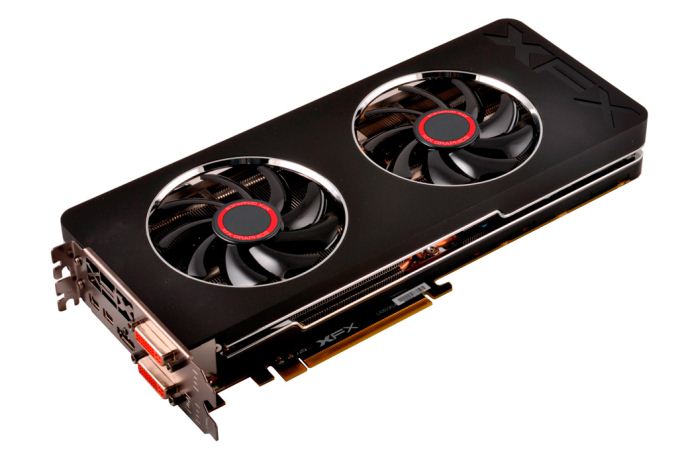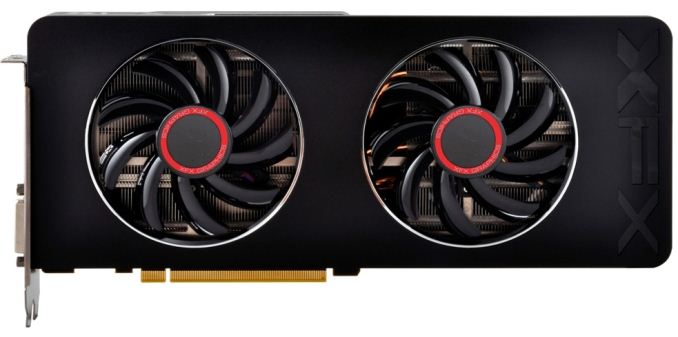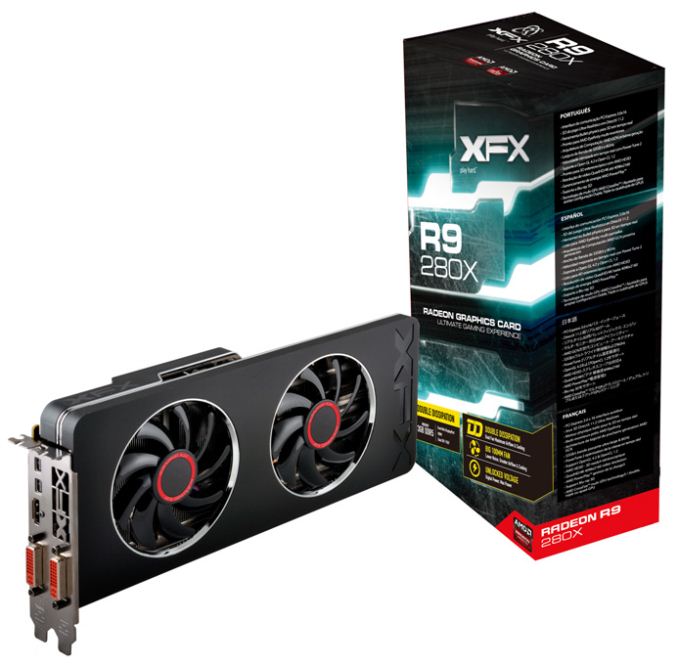The Radeon R9 280X Review: Feat. Asus & XFX - Meet The Radeon 200 Series
by Ryan Smith on October 8, 2013 12:01 AM ESTXFX Radeon R9 280X Double Dissipation
The first of our R9 280X cards is our reference-like sample, XFX’s Radeon R9 280X Double Dissipation. The R9 280X DD is XFX’s sole take on the 280X, utilizing a new and apparently significantly revised version of XFX’s Double Dissipation cooler, and paired with a 280X operating at the 280X’s reference clocks of 850MHz core, 1000MHz boost, and 6GHz RAM. Since there isn’t an overclock here, XFX will primarily be riding on their cooler, build quality, and other value add features.
Diving right into the design of the card, the R9 280X DD is a fairly traditional open air cooler design, as is common for cards in this power and price range. This basic design is very effective in moving large amounts of heat for relatively little noise, making the usual tradeoff of moving some of the cooling workload onto the system’s chassis (and its larger, slower fans) rather than doing the work entirely on its own.
In XFX’s case this is a new design, having forgone their older Double Dissipation design that we first saw on their 7970BEDD back in 2012. What’s changed? Without going into minute details, practically everything. At first glance you’re unlikely to even recognize this as an XFX card due to the fact that this is the first such product from XFX using this design, which aesthetically looks almost nothing like their old design.
First and foremost XFX has gone for the oversized cooler approach, something that’s become increasingly common as of late, equipping the card with one of the larger coolers we’ve ever seen. At 100mm in diameter the two fans on XFX’s design are among the biggest we’ve ever seen, pushing the card to just over 11.1 inches long while causing the heatsink and shroud to stand about 0.75” taller than the board itself.
Drilling down, XFX is using a two segment heatsink, the combined length of which runs the complete length of the card. Providing heat conduction between the GPU and the heatsink is a set of 6 copper heatpipes mounted into a copper base plate. 4 of these heatpipes run towords the rear of the card and the other 2 to the front, perpendicular to XFX’s vertical fin heatsink. Meanwhile cooling for the various discrete components on the board, including the memory, is provided by a separate cut-out baseplate that covers most of the card. There isn’t any kind of connection between the baseplate and the heatsink proper, so it’s the baseplate and any airflow over it that’s providing cooling for the MOSFETs it covers.
Moving on to XFX board, it looks like XFX isn’t doing anything particularly exotic here. XFX is using their standard Duratec high-end components, which includes using solid caps and chokes (typical for all cards in this power category) along with their IP-5X dust free fan. A quick component count has us counting 7 power phases, which would be the reference amount for a 280X, meaning we’re looking at 5 phases for the GPU, and another 2 phases for the memory and I/O.
Meanwhile for I/O XFX implements the common Radeon display I/O configuration of 2x DL-DVI, 1x HDMI, and 2x Mini DisplayPort 1.2. All the while external power delivery is provided by a set of 6pn + 8pin power connectors, as to be expected for a 250W card. With that in mind XFX’s design should have at least some overclocking headroom, but XFX doesn’t provide any overclocking software so you’ll need to stick with Catalyst Overdrive or 3rd party utilities such as MSI Afterburner.
Finally, as a Double Dissipation product the 280X DD is covered by XFX’s lifetime warranty policy, contingent on registering the card within 30 days of purchase. Interestingly XFX remains one of the few board partners that still offers any kind of lifetime warranty, making them fairly exceptional in that regard. As for pricing we’re listing the XFX card at $329 at the moment, though there is still some confusion over whether that’s the final price or not as our XFX rep seemed unsure of that. As is sometimes the case in this industry, we get the impression that they were waiting to see what other manufacturers were going to charge, in which case we suspect the actual launch price will be lower than that. We’ll update this article once we have final pricing information available.













151 Comments
View All Comments
Pantsu - Tuesday, October 8, 2013 - link
Can't say for these cards, but at the very least if you're using multi monitor setup, you can forget about zero core. Actually I've never managed to get my 7970 to go zero core in any circumstance.Pantsu - Tuesday, October 8, 2013 - link
Rebadge may be a bit of a harsh word, but ultimately these cards bring very little change over what was offered before. The only significant changes are the price and the I/O setup, unless you care about the cooler shroud in the cheapo skus. I'd say now is the time to go bargain hunting for 7000 series cards while supplies last. You get a nice game bundle and practically the same cards for less. I've already had my eye on a 249€ 7970 for CF purposes, but I'm still hesitant since AMD hasn't released the new frame pacing driver for eyefinity.Now what I'd really like to know is if these 200 series "definetely not a rebadge" cards will work in crossfire with the 7000 series "cousins".
Pantsu - Tuesday, October 8, 2013 - link
Oh they in fact do move in herds...err work in Crossfire.Impulses - Tuesday, October 8, 2013 - link
I had been thinking about going with two GTX 760 in SLI for a budget 5760x1200 setup... It might not handle every game maxed but it's still faster than my cutter 6970x2 setup (and for a similar amount of money as what I paid for it a few years ago)... The 280X is tempting at only $100 more for two cards tho. I can afford two GTX 780 if I really wanted, I'm just nor sure I can justify spending that kinda money on GPU... And two 770 just didn't seem like a large enough jump for an extra $300 over a $500 setup (760x2). Decisions, decisions...Impulses - Tuesday, October 8, 2013 - link
Heh, started writing that reply and forgot about the main reason I did, AMD's slow progress with frame pacing for EF is the one thing holding me back. Guess I'll hold out for some moreDdriver releases an possibly the BF Mantle patch.AWilco - Tuesday, October 8, 2013 - link
Is there an explanation of the poor performance of the ASUS card at 1080p + 4x MSAA in BF3? Looks to be an aberration comparing it to most other graphs (haven't done an exhaustive look).Ryan Smith - Tuesday, October 8, 2013 - link
That would be your fat fingered editor making a typo. Fixed.blanarahul - Tuesday, October 8, 2013 - link
I just read that you guys had only 24 hours to test these GPUs. Is that true?Ryan Smith - Tuesday, October 8, 2013 - link
Oh goodness no. We had much longer than that. But a week goes by very quickly when you need to generate your results from scratch and write a 20K word article.Samunosuke - Tuesday, October 8, 2013 - link
The 290 and 290X are going to be really intriguing especially on a price/performance scale. The price will be the determining factor for the 290X, undercut GTX 780 and you have a winner.